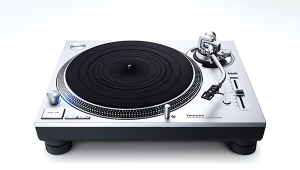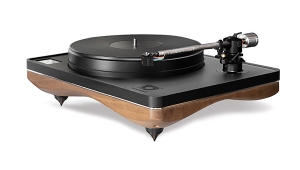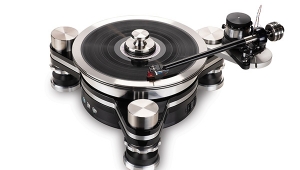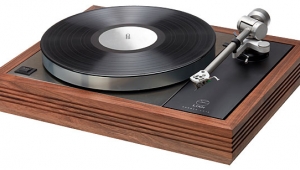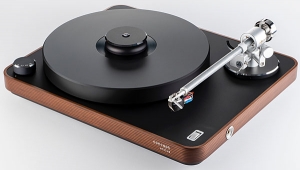| Columns Retired Columns & Blogs |
Simon Yorke Designs Series 7 Precision LP Playback System
"My original goal was simply to design a better turntable than the Linn because at that time in the UK, Ivor Tiefenbrun was the man—he was the patron saint and all that. And all the hi-fi mags were full of Linns. He did for turntables, in a way, what Mark Levinson (the man) did for amplifiers."
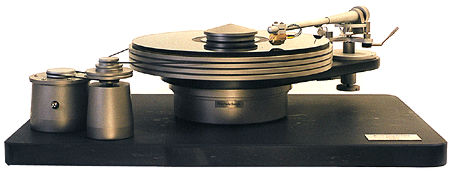
So said turntable designer Simon Yorke when I visited him recently in Washington, DC. Yorke's motivation 15 years ago wasn't competitiveness, he recollected; it was that, at the time, he couldn't afford a Linn Sondek.
What was this 40-year-old Brit doing in the nation's capital? Installing two more of his transcription turntables in the Library of Congress' Motion Picture, Broadcasting, and Recorded Sound Division, where they're being used to transcribe and archive the Library's vast collection of transcription discs, 78s, and other "relics" of the analog era. Not bad for a guy with no formal mechanical or electronic training, who describes his achievements as based on "a small amount of talent coupled with a large amount of bloodymindedness."
Currently, the Library of Congress has three Yorke turntables; eventually it plans to own five. In case you're wondering, the information Yorke's 'tables extract from those rare, priceless, fragile grooves is being transferred to ¼" analog tape. The Library doesn't yet consider any digital medium "archival." During my visit (which I cover in greater detail in this month's "Analog Corner"), Sam Brylawski, head of the Recorded Sound Section, showed me a transcription disc of an Armed Forces Radio Network broadcast from The Grand Ol' Opry containing an unreleased Hank Williams performance, slated for an upcoming PolyGram Chronicles boxed set—just one of millions of buried treasures lurking in the vaults.
Having a 'table and arm chosen as the archival reference for an organization like the Library of Congress is an impressive vote of confidence, to be sure—especially given the American competition. But, as consumers and taxpayers, we should take the endorsement with a healthy dose of skepticism: after all, we're talking about Washington, and what makes Washington spin is as much about politics as anything else—not that Yorke came to town to break in his governmental kneepads.
What brought his 'table to the Library originated as part of a bid contract to supply the institution with equipment for the archiving facility. Mark Levinson, no big fan of analog, already had a relationship with Yorke, selling his turntables to Luddite Cello customers who still play records. Levinson bid on the contract and won. So the endorsement comes more from Levinson than from the Library of Congress.
Nonetheless, from what I could gather from snooping around, the turntables Yorke has built for the Library—specially designed, laptop-computer–controlled, archival variations of the model under review here, with 16" bidirectional platters, 12" arms, infinitely adjustable speed control, etc.—were meeting and exceeding the high expectations of the archivists and librarians who'd helped develop the contract. That is an endorsement.
It's a (stainless) steal!
The first thing I realized while setting up the Yorke 'table was that there's no visible acrylic. Acrylic—the building block of the modern turntable universe—and there's none. Scary. The next thing I noticed was that there's no plinth. There's a base, but no platform in the usual sense. Instead, the Yorke is built upon a solid, cylindrical, and very heavy stainless-steel base 6" in diameter, which has a damping ring and an acrylic plate recessed into the bottom.
The unit is precision-drilled for the low-friction spindle sleeves, forming a very rigid, massive, stable support mechanism for the platter. The bearing shaft itself and the hub spindle are also fabricated from (a different kind of) hardened stainless steel. The bearing thrust plate is a double-ball system with one ball sitting at the bottom of the housing in a 60° cut point, the other in a recess on the bottom of the bearing shaft. The point-to-point contact of the two carbon/chrome balls (sourced from aerospace applications), means that if there is wear, returning the system to "new" consists of replacing two relatively inexpensive balls, which take the entire load. But Yorke claims that wear is unlikely; he figures the bearing should last 50 years with continuous use, as long as the lubrication is maintained.
Before installing the spindle bearing, you have to secure the laser-cut, pear-shaped armboard using three meaty hex-head bolts. The ¾"-thick, very light but rigid armboard is fabricated not from acrylic or a constrained-layer-damped composite, but from a "multilaminate of natural materials" that has been painted and/or coated with an attractive gray finish. Looking down a hole drilled through the material, it looks like (are you ready for this?) some kind of pressure-formed, marine-grade plywood—the last material you'd think appropriate for this application. As I bolted the board down, I kept thinking Black Diamond Racing board, or some other high-tech material—like the constrained-layer-damped TNT armboards made by Immedia and Graham Engineering.
I questioned Yorke about the laminate; he told me defiantly that "I have a box as big as this sofa at home full of materials I've tried for armboards. It sounds preposterous, but I've been driving along in my car and I've seen things lying by the side of the road and I've put on the brakes and jumped out of the car and grabbed this thing and put it back in the car and taken it home and machined an armboard out of it to see what would happen and listened to it. It's kind of obsessive, really. You can talk about machining and all the bullshit people talk about—bearing tolerances—but materials are awfully important. And if you change these materials you can make [two] turntables from the same set of drawings...[that have] completely different sonic signatures. I've got boxes worth of platters. I've made platters out of wood, stone, glass—any number of things. The same with armboards."
Once the armboard is bolted into place, you fill the bearing well with enough supplied oil so some gets displaced when the shaft is inserted, and the two balls finally make contact. Then it's time to carefully place the precisely balanced 24-pound stainless-steel platter ("almost exclusively from Austenitic nonmagnetic stainless," according to the instructions) over the spindle hub and onto the shaft crown. The platter is machined so that most of its weight is at the outer circumference. Due to the flywheel effect, this increases speed stability to the point where, Yorke told me, no electronic regulation is required. Yorke can supply either an acrylic cork-backed mat or one made of graphite, either of which is used in conjunction with a heavy, beautifully machined spindle weight. The only problem with the weight is that, once you touch its cool, smooth surface, you won't want to put it down!
Now it's starting to look like a turntable!
Outboard drive is via a small, very-low-torque, 12-pole, 3½W Airpax AC synchronous motor driven at 90V instead of 110V via a stepdown transformer in line with the power cord from the motor. According to Yorke, the lower voltage both decreases the vibration level and makes the motor last longer. "A motor is a vibrating animal. You cannot get away from that," he told me. That's why he opted for the smallest, lowest-vibration motor he could find that could still do the job. The freestanding unit, topped by a wide, flat pulley, is housed in a heavy stainless-steel chassis.
- Log in or register to post comments
